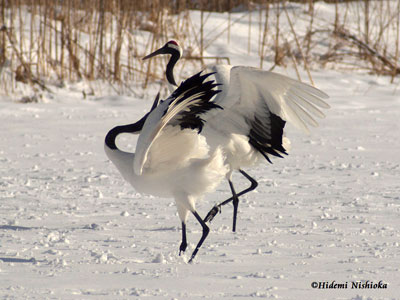 East Asia’s Red-crowned Crane has achieved remarkable cultural significance throughout its range, in part because of its dramatic and extraordinarily ritualized displays, including the remarkable arch display. Limited to this species, the dramatic rise and curve of wings – black against white – most frequently occurs immediately after an individual, a pair, or a family joins a flock of cranes. Arch displays are common in Hokkaido, where Red-crowned Cranes gather at feeding stations during the colder months.
East Asia’s Red-crowned Crane has achieved remarkable cultural significance throughout its range, in part because of its dramatic and extraordinarily ritualized displays, including the remarkable arch display. Limited to this species, the dramatic rise and curve of wings – black against white – most frequently occurs immediately after an individual, a pair, or a family joins a flock of cranes. Arch displays are common in Hokkaido, where Red-crowned Cranes gather at feeding stations during the colder months.
While observers have speculated that the arch display – which you can sometimes see in the captive birds at the International Crane Foundation – is a threat directed at cranes in the vicinity, no one really knew for sure.
Researcher Kohei F. Takeda at the Graduate University for Advanced Studies, Japan spent three years observing and analyzing crane behavior associated with the arch display, working in collaboration with the Red-crowned Crane Conservancy of Kushiro, Japan. His data clearly indicate that the arch is related to competition among closely adjacent cranes, and the display is actually a signal of readiness for aggressive behavior. The newcomer to the flock – normally a male – lets his neighbors know he is a crane to be reckoned with.
Takeda’s finding has conservation implications for this endangered crane. Takeda and his co-authors write, “In Japanese populations, high densities at feeding stations are a serious problem because of the increased risk of infectious diseases. Application of our behavioural results can provide an efficient way of assessing the gathering patterns of the cranes. In practice, the degree of competition at feeding stations could potentially be assessed by simply measuring the frequency of the arch display. Such behavioural monitoring at feeding stations could provide basic knowledge of the species, and lead to more effective conservation through an understanding of dominance and the potential problems associated with high densities.”
Crane experts would like to find ways for these cranes to disperse more widely across the landscape even during Hokkaido’s chilly winter conditions. Frequency of arch displays could help measure the success of these efforts.
By the way, you may wonder why the male Red-crowned Crane at the International Crane Foundation sometimes gives the arch display just after you arrive before his pen. He is indicating his willingness to fight. Since you don’t know the displays that you might use to communicate back, it’s fortunate the fence extends between you.
Click here to view the full text of the article, and click here for a second crane article from Hokkaido, on using Red-crowned Cranes and Blakiston’s Fish Owls as biodiversity indicators.
 Story submitted by Jim Harris, International Crane Foundation Senior Advisor. Learn more about our East Asia program.
Story submitted by Jim Harris, International Crane Foundation Senior Advisor. Learn more about our East Asia program.
